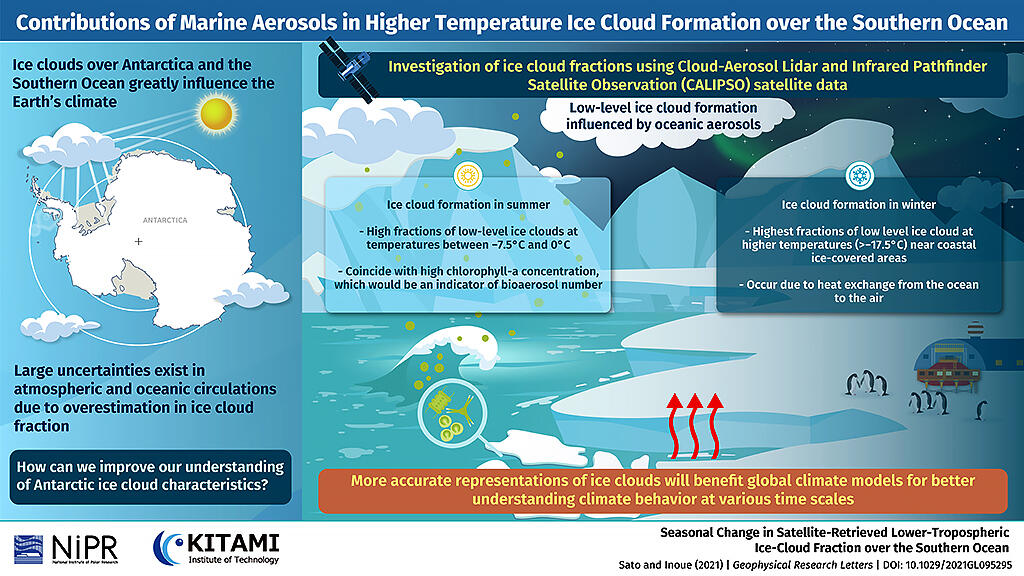A research team, composed of Assistant Professor Kazutoshi Sato of the Kitami Institute of Technology and Associate Professor Jun Inoue of the National Institute of Polar Research, investigated the abundance of ice clouds in the Pacific Ocean and the coastal areas of Antarctica from data that determine the phase state of clouds (water clouds or ice clouds) obtained by satellite observations. Results showed that in the summer, the abundance of ice clouds was higher than that in other temperature zones in an environment where the temperature in the sky is approximately −10 °C or higher. It was also suggested that particles (aerosols) derived from marine organisms might form the nuclei of ice crystals and promote the formation of ice clouds.
During this research, it was clarified that in winter, the abundance ratio of ice clouds is high in an environment where the temperature in the sky is approximately −20 °C or higher during periods of strong winds where a large number of aerosols are supplied from the sea to the atmosphere. Since the number of ice clouds greatly affects the amount of solar energy received by the Earth, it also affects the process of sea ice formation and the reformation of ice sheets at high latitudes. Since ocean-derived aerosol particles promote the formation of ice clouds even at relatively high temperatures, it is important to investigate the relationship between ice clouds and ocean-derived aerosol particles to understand the climate system and its changes. However, few observational studies have focused on the widespread Southern Ocean ice clouds.

Credit: Kazutoshi Sato (Kitami Institute of Technology)
The research team used data captured by the Cloud-Aerosol Lidar and Infrared Pathfinder Satellite Observation (CALIPSO) satellite from 2006 to 2015, and analyzed the phase state and temperature of clouds formed in the three regions of Antarctica and the Southern Ocean (Pacific, Atlantic, and Indian Oceans). As a result, it was found that the Southern Ocean clouds (lower clouds) in the lower troposphere at altitudes of 2 kilometers or less had a high ice cloud abundance ratio relative to that of all lower clouds (water clouds + ice clouds) in the coastal area of Antarctica in a relatively high temperature environment (winter: −17.5 to −10 °C, summer: −7.5 to 0 °C). In such a high temperature environment, ice clouds are not formed without the presence of fine particles that form the core of ice crystals.
Next, the origin of the ice crystal nucleus particles was examined. In the coastal areas of Antarctica in the Indian Ocean in winter (south latitude, 66 degrees south), the proportion of ice clouds existing at temperatures below −30 °C peak at 80% or more. However, even at a relatively high temperature of −17.5 to −10 ° C, the abundance ratio reached a maximum of 50% or more. The ice clouds that exist with this relatively high temperature have a high abundance ratio when the cold air blowout from Antarctica is strong (heat exchange index between the atmosphere and the ocean is high). Substances derived from the ocean (aerosols in the ocean) may also be supplied to the atmosphere to increase the formation of ice clouds in a high temperature environment with high heat and evaporation.
Meanwhile, in summer, the abundance ratio of ice clouds in a high temperature environment peaks at around 60% at a temperature of −7.5 ° C or higher. As the abundance ratio of ice clouds increases, the concentration of chlorophyll a on the sea surface also simultaneously increases. Aerosols released from the ocean could increase the abundance of ice clouds at relatively high temperatures. The high abundance of ice clouds tends to be similar in each season even in the coastal areas of Antarctica in the Atlantic Ocean and the Pacific Ocean. Therefore, it is thought that the number of aerosols derived from the ocean increases during the same process, which affects the increase in ice clouds.
According to Assistant Professor Sato, "The Data suggests that marine aerosols emitted from the ocean contribute to low-level ice-cloud formation over the Southern Ocean even under higher temperatures. In situ observations such as atmospheric aerosol and seawater sampling are required to demonstrate these relationships. The research team plans to directly observe clouds and aerosol particles in the Southern Ocean using the Antarctic research ship "Shirase" in the Antarctic Research Expedition from FY2010".
This article has been translated by JST with permission from The Science News Ltd.(https://sci-news.co.jp/). Unauthorized reproduction of the article and photographs is prohibited.




